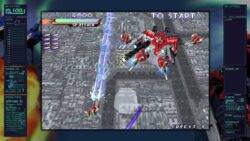Ray’z Arcade Chronology – RayStorm in all its 3D glory (Picture: Inin)
Taito’s trilogy of classic 2D shooters rise from the grave, but how well does RayStorm and its siblings hold up after almost three decades?
As the first person shooter continues its journey from the most popular genre in gaming to relative obscurity we can’t help but think of the time when the term shooter meant things like Gradius and R-Type. Nowadays, they’re usually referred to as a shmup, short for shoot ‘em-up, and if first person shooters are on the decline it seems safe to say that their 2D equivalents are already dead and buried, only occasionally escaping from their tomb via museum-like exhibitions such as this.
New 2D shooters do occasionally get released by indie developers but it’s been years since a major publisher tried, even as a digital-only release. We can understand that, given just how old-fashioned they are, but we’re continually frustrated that nobody has tried to expand on Star Fox 64’s linear sections, which were exactly how we imagined one of these games would look and play in 3D.
Star Fox 64 was released in 1997 and yet RayForce, the oldest title in this three-game compilation, came out only three years earlier. At that time not only was 3D, and the arrival of the PlayStation, beginning to make 2D visuals look obsolete but shmups were starting to embrace the bullet hell concept that helped to push the genre firmly into niche status. Which makes the Ray trilogy of games – as they are rather awkwardly known – something of an end of an era phenomenon.
The last attempts at making a mainstream, reasonably budgeted, shmup were R-Type Final and Gradius 5 – great games but ones where nostalgia alone was a significant part of the appeal. However, with RayCrisis and its predecessors, developer Taito was attempting to push the genre forward by embracing 3D graphics and trying to keep pace with more modern action games. In that respect they failed but taken on their own merits these are all very good examples of their craft.
Despite being the first entry in the series, RayForce has a bewildering array of alias around the world, as for legal reasons it had to change its name to Layer Section in Japan and Galactic Attack in the US, while in Europe the arcade version was known as Gunlock. It was ported to the Saturn and PC in the 90s, but the only version included here is the original arcade edition.
The Japanese name isn’t as random as it sounds, as one of the game’s main gimmicks is that you can fire at two different layers of the screen at once, although really that’s just a slight variation on 1982’s Xevious, which allowed you to both shoot forward and drop bombs on the ground at the same time.
Unlike its successors, RayForce uses only 2D sprites but because it arrived relatively late in the day, technology-wise, they’re gloriously chunky sprites with a real weight and solidity to them. The game frequently veers into bullet hell shooter territory, especially during boss battles, with an enormous amount of gunfire ricocheting around the screen. Much of it comes from you, especially the lock-on laser that can target up to eight enemies at once and is the only way to attack enemies below you.
1996 sequel RayStorm works in much the same manner, except now with a choice of two ships, each able to launch a new smart bomb style attack by filling up a meter every time you use multiple lock-ons. Plus, if you attack a single target with the maximum number of lock-ons you activate a unique special attack, depending on which of the two ship you’re flying.
Despite what you might imagine about mid-90s 3D graphics, RayStorm still looks very impressive, although the camera angle is no longer top-down and is titled lower, closer to your ship, which can take a bit of getting used to in terms of judging distance. There are also some surprisingly ambitious camera movements, which go a long way to proving the new style of visuals are more than just a gimmick.
1998’s RayCrisis is even more inventive in this regard and while it sometimes bites off more than it can chew, with the twitching polygons of the early PlayStation era sometimes spoiling the illusion of solidity, there is an attempt to add more nuance to the scoring system, as you try to take out enemies using both weapons at the same time.
Lock-ons can now be carried out automatically but the reticule also moves along with your ship, which allows you to target enemies on either layer. There’s also a new system which punishes you for simply avoiding enemies, instead of fighting them, by fast forwarding you to the final boss, and the game’s bad ending, if you miss too many.
A second, slightly cheaper, compilation has been released at the same time as this, called RayStorm X RayCrisis HD Collection, but it omits RayForce. The physical version of Ray’z Arcade Chronology, which we haven’t seen, also contains a previously unseen prototype of RayForce called R-Gear, so it’s a shame that there are essentially three different collections with no way to upgrade between them.
Ray’z Arcade Chronology- RayForce has some great 2D graphics (Picture: Inin)
To make things worse, none of the home versions are included in any version of the compilation, which is a real shame as they contained quite a bit of new content and, let’s face it, there’s not going to be another RayForce collection in a very long time.
At least you can say these are the definitive versions of the original arcade games though, with the involvement of emulation specialist M2 guaranteeing these are pixel perfect arcade conversions, with good presentation and plenty of options. There’re also brand new HD remasters of RayStorm and RayCrisis (but not RayForce) included, which help to make them look a little better on modern TVs.
More: Trending
However, there’s almost no museum content, in terms of concept art galleries and the like, which again seems like a missed opportunity. These are not uncommon problems for retro compilations but after seeing how well Atari 50: The Anniversary Celebration handled itself, with its mountains of behind the scenes information for every game, this feels very bare bones.
No doubt the Ray series struggles to justify any additional money being spent on it, but while it’s great to play these games again it’s frustratingly easy to imagine what a more fully featured collection might have contained.
Ray’z Arcade Chronology review summary
In Short: Three great 2D shooters, lovingly recreated and, in the case of RayStorm and RayCrisis, updated for the modern era – even if some corners have been cut.
Pros: All three games are good and tell a little mini-history of the genre during the 90s. RayForce’s 2D sprites are great and the other two make surprisingly good use of early era 3D polygons. Top notch emulation.
Cons: There’s no HD version for RayForce and nothing at all from any of the home versions. No museum content of any kind and only including R-Gear in the physical edition is asinine. Not cheap.
Score: 7/10
Formats: PlayStation 4 (reviewed) and Nintendo Switch
Price: £44.99
Publisher: ININ
Developer: M2 and Taito
Release Date: 30th June 2023
Age Rating: 7
Email gamecentral@metro.co.uk, leave a comment below, follow us on Twitter, and sign-up to our newsletter.
MORE : Synapse review – the new reality of first person shooters
MORE : Dave The Diver review – oceans of fun
MORE : Everybody 1-2-Switch review – Nintendo’s least wanted sequel
Follow Metro Gaming on Twitter and email us at gamecentral@metro.co.uk
To submit Inbox letters and Reader’s Features more easily, without the need to send an email, just use our Submit Stuff page here.
For more stories like this, check our Gaming page.
Sign up to all the exclusive gaming content, latest releases before they’re seen on the site.
This site is protected by reCAPTCHA and the Google Privacy Policy and Terms of Service apply.
Taito’s trilogy of classic 2D shooters rise from the grave, but how well does RayStorm and its siblings hold up after almost three decades?





